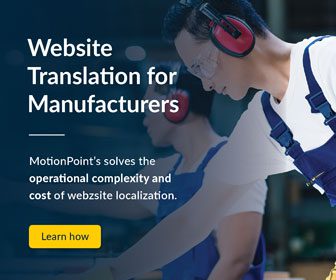As your company expands to serve customers in global markets, it becomes pretty clear, pretty quickly, that you’ll need fully-translated websites to serve your new international customers.
But to truly succeed, you must deliver this translated content in ways that are absolutely seamless and instant to your global customers. As far as they’re concerned, the process should be invisible. That’s a lot harder than it sounds—especially for companies that want to take on this challenge using in-house resources.
It’s Really Complicated
At first glance, an in-house website translation project doesn’t sound particularly imposing. It’s just swapping English content for slightly different content, right?
Wrong. Traditionally, the manual process of translating website content involves a time-wasting, iterative process of exporting content, sending source files to translators, editing those translations for quality, importing the content into your CMS, testing, publishing and more.
Translation workflows grow exponentially, depending on your site’s scope and the number of multilingual websites you manage.
That sounds daunting. And that’s just for the content on one webpage. Repeat that process for every page on your site. Add in any additions to the scope of the site, or customizations for specific markets. And then multiply all that effort by the number of multilingual websites you’ll be managing.
The scope of website translation projects are massive and overwhelming—and they’re beyond the capabilities and resources of most in-house teams. Consider the challenges you’ll face as you launch and continually operate your multilingual sites:
- Do you have enough people to manage these new technologies and processes?
- Do your people have the technical expertise to launch and maintain multiple multilingual instances of your CMS?
- Do your people have the linguistic and cultural expertise to translate (and edit) your multilingual content?
- Do they all have the bandwidth to take on these tasks alongside the full-time workloads they already manage?
In-house translation leads to higher costs in the long run. Not only do these manual processes represent a massive time suck for those involved, but the unanticipated workflow challenges that emerge will only cause more delays. Worse still, the higher costs may not be felt directly at first … but they’ll quickly grow when staff time and other intangibles are factored in.
Your in-house team is great at managing your primary-market site, but they’ll be outclassed by a website translation project.
It’s About More Than Translation
When it comes to website translation, you have to get past “line-item” thinking.
When it comes to budget allocation, the concept of translation is often seen by stakeholders as a single line item. That makes sense—after all, that’s how vendors submit their invoices. It’s simply assumed that an in-house website translation project can be accounted for in the same way.
But “translation” is about far more than translation. Dozens of individual elements contribute to those costs, including tasks that few executives have full visibility into. Beyond the actual workflow of translating content, “translation” also includes staff time, technology usage, access to specific resources and much more.
Let’s examine just one of those elements mentioned above: technology usage. The scope and cost of creating or managing website translation technologies can quickly overwhelm most in-house teams. Most marketers hope the multilingual features of their CMSs can efficiently handle the workload. Unfortunately, those tools are often undercooked, and can’t handle the day-to-day rigors of website translation.
‘Website translation’ is about more than translation. It also involves technologies, processes and unique expertise.
Developing solutions for those shortcomings requires time and attention—and additional money for additional technologies. And even with those investments, it’s often unclear if the solution will work in the long-term. Updates or changes to your technology stack down the road often create unforeseen challenges and costs.
Conclusion
Remember, the actual task of translating digital text, images and other online elements represents only a sliver of the true cost of website translation. Costs should also cover technologies, smart translation management, and efficient software built to save you money.
The best website translation vendors provide these capabilities and more, eliminating the need for in-house teams (and the costs associated with building those teams). Look for solutions that combine the best translations with leading content-management technologies that minimize costs and speed to market.
As you speak to these vendors, be sure to get a clear idea of what “translation” means to them, and the services included in with those translations. Remember, you should be paying for more than mere translated words. You should be paying for excellent translation management software, and more.
Last updated on September 07, 2017
